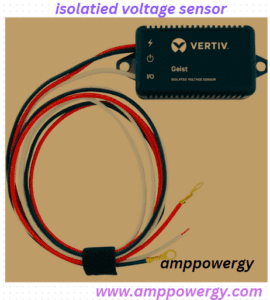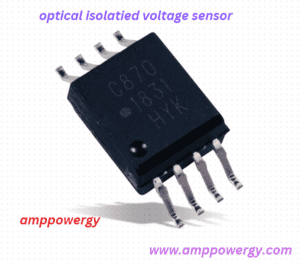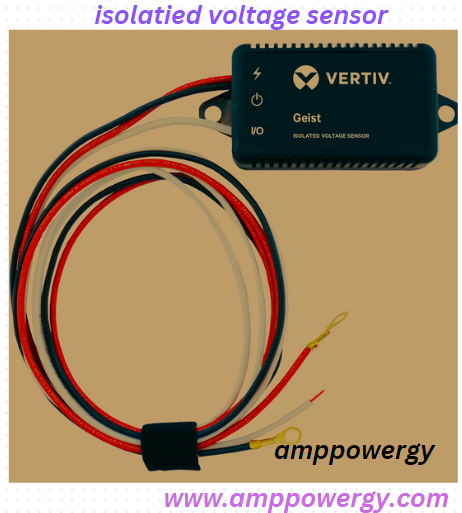What is Isolated Voltage Sensor
An isolated voltage sensor is a device which is used to measure electrical voltage without being connected electrically to it and this is done through isolation barrier and this isolation barrier can implement with the help of different techniques which include optical, magnetic and capacitive isolation. Isolated voltage sensors are used in high voltage applications such as power electronics and industrial control systems, where safety is important. It can measure high voltage.
It is very important in application where high voltage is measured with respect to ground. It is also used in applications where voltage changes rapidly or voltage to be measured in noisy environment or when there is a risk of shock.

Different technique of isolation in isolated voltage sensor
There are three common techniques used in isolated voltage sensors which are used to create a barrier between the measurement and the voltage source. The techniques are listed below.
- Optical isolation
- Magnetic isolation
- Capacitive isolation
What is an Optical isolation
Optical isolation is the type of technique of isolated voltage sensor which uses light for the transmission of signals across the isolation barrier. First the voltage is converted into light signal and then transmitted to the isolation barrier to the measurement system. This technique of isolated voltage sensor gives high isolation voltage, low power consumption and provides high noise immunity.

Optical isolation has different advantage and disadvantage which is listed below.
Advantage of Optical Isolation
- It ensures safety that is it provides isolation of two section of the circuit means it isolate physical and electrical section.
- It minimizes noise and EMI.
- It is also reducing interface.
- It is small and not so costly.
- Optical isolation can limit the voltage in multiple circuits.
Disadvantage of optical isolation
- It is not best for an application which have high frequency.
- The response time of optocoupler in optical isolation is slower than the response time in magnetic isolation.
- It is very sensitive to the temperature.
- It is open to aging and degradation over time.
What is Magnetic isolation
Magnetic isolation is the type of technique of isolated voltage measurement which uses Magnetic field to transmit signal across the isolation barrier. First the voltage is converted to the magnetic field and then transmitted across the isolation barrier to the measurement system. This technique of isolation barrier gives high isolation voltage, high common mode rejection and provides high noise immunity.
Magnetic isolation has different advantage and disadvantage which is listed below.
Advantage of Magnetic isolation
- It can transfer more power than optical isolation.
- It gives high common mode rejection and high noise immunity.
- It can be used for high frequency applications.
- Its response time is faster than the optical isolation.
Disadvantage of Magnetic isolation
- It is more expensive compared to optical isolation.
- Its size is larger than optical isolation.
- It is open to saturation.
- It is also open to the temperature range.
What is Capacitive isolation
Capacitive isolation is the type of technique of isolation voltage sensor which uses capacitors to transmit signals across the isolation barrier. First voltage is converted to the electric field and then transmitted across the isolation barrier to the measurement system. This technique of isolated voltage sensor gives high isolation voltage, low power consumption and provides high noise immunity.
Capacitive isolation is different advantage and disadvantage which is listed below.
Advantage of Capacitive isolation
- In term of size and energy transfer Capacitive isolation is very suitable for many applications.
- It provides high common mode immunity and low electromagnetic emission.
- Capacitive isolation has a longer lifetime.
- It is not open to magnetic field.
- It can be bidirectional.
Disadvantage of Capacitive isolation
- Its isolation is lower than magnetic isolation.
- Its propagation delay is longer than magnetic isolation.
- It is more expensive as compared to optical ones.
- It is open to temperature changes.
Apart from optical, magnetic and capacitive isolation techniques there are more techniques which are used in isolated voltage sensors which are listed below.
What is Resistive isolation
Resistive isolation is a type of technique of isolated voltage sensor which uses a resistor to create isolation barrier between voltage and measurement system. First the voltage is converted into current and then this current is transmitted across the isolation barrier to the measurement system. This technique provides.
- Low-cost isolation
- Lower isolation voltage
- Higher power consumption
What is Inductive isolation
Inductive isolation is a type of technique of isolated voltage sensor which uses an inductor to create isolation barrier between voltage and measurement system. First the voltage is converted to the magnetic field and this magnetic field is then transmitted across the isolation barrier to the measurement system. This technique provides.
- High isolation voltage
- High common mode rejection
but the response time of this technique is slower than the other technique.
What is Piezoelectric isolation
Piezoelectric isolation is a type of technique of isolated voltage sensor which uses Piezoelectric isolation to create isolation barrier between voltage and measurement system. First the voltage is converted to the mechanical force and then this force is transmitted across the isolation barrier to the measurement system. This technique provides.
- High isolation voltage
- High common mode rejection
But this technique has a lower bandwidth than the other techniques.
Types of isolated voltage sensor
There are different types of isolated voltage sensor which are used in different applications which includes power monitoring, motor control and industrial automation. The types are listed below.
- Isolated amplifiers
- Isolated voltage transducer
- Isolated voltage to frequency converter
Working of isolated voltage sensor
Isolated voltage sensor works by detecting the voltage of an electrical circuit without connecting to it. Voltage divider circuit is used in the sensor which is used to reduce the voltage to the level which can be measured by the sensor. The voltage divider circuit of the sensor is connected to the amplifier, the amplifier amplifies the signal of the voltage and thus provides isolation between the input and output of the sensor.
The voltage signal of the amplifier is then converted to the digital signal, and this is done through ADC (analog to digital converter). This digital signal is processed by a microcontroller or can be processed by computer to do different function which includes.
- Power failure detection
- Load detection
- Safety switching
- Temperature control
- Power demand control
Let’s take an example of ISO224 isolated amplifier which is used to 480 V isolated voltage sensing measurement with the help of voltage divider circuit. The voltage divider circuit is used to reduce the voltage from 480 V to 12V which matches the input range of ISO224 isolated amplifier. This ISO224 amplifier can power from both the high and low side of the power supply.
Advantage of isolated voltage sensor
- isolated voltage sensor has high accuracy.
- isolated voltage sensor has low cost.
- isolated voltage sensor high performance.
- It is very useful an application which requires an isolation such as power failure detection, load detection, temperature control and power demand control.
Disadvantage of isolated voltage sensor
- It can be affected by environmental changes.
- It can also be affected by contamination such as gas.
- It has low frequency response, like it requires more time to perform their function when pressure change occurs.
- The amplifier noise is high in the sensor itself.
Why to use isolated voltage sensor
It is used in different applications which include power failure detection, load detection etc. Isolated voltage sensor has high accuracy, low cost and good performance. It is very suitable for the application which requires an isolation between input and output circuit.
The main reason to use an isolated voltage sensor is to provide safety. It is used to provide electrical isolation between input and output circuit which is very useful to prevent electrical shoch and Demange to the device. It finds its application in very harsh and danger environment like when electrical circuit is exposed to high temperature, high voltage or any other hazard condition.
How do I choose a right sensor for my application
It is a very difficult task to choose the right sensor for your application. Here are some important steps to follow. I hope it can help you to choose the right sensor.
- Know the variable to be measured: first, determine the variable to be measured such as it can be pressure and temperature or any other quantity.
- Find the range of measurement: find the minimum and maximum quantity of the variable which needs to be measured.
- Consider the environment: it is very important to consider the condition of the environment in which the sensor will be used to measure some quantity, for example temperature, pressure, humidity etc.
- Choose the better sensing principle: choose the sensing principle which is better for your application. For example, if your measuring quantity is temperature then you should go to thermocouples, RTD etc.
- Keep in mind the cost: consider the cost of the sensor.
- Consider the output signal: consider which output signals do you require, for example analog and digital signals.
- Consider the reliability: keep in mind the reliability of the signal that as can it fulfill your application requirements.
- Consider the installation: consider the ease of installation of the sensor and think whether it required any other device for installation.
Frequently asked question about isolated voltage sensor
Q1: what is an isolated voltage sensor?
Ans: it is a device which is used to measure voltage without connecting to the electrical circuit. A voltage divider circuit is used in it which is used to reduce the level of voltage to a level which can be measured by the sensor.
Q1: what is the advantage of using isolated voltage sensor?
Ans: the advantage of using isolated voltage sensor is
- It is useful for electrical isolation.
- Used to detect power failure, load detection, safety switching etc.
Q1: What are the disadvantages of using isolated voltage sensor?
Ans: the disadvantages of using an isolated voltage sensor includes
- It can be affected by the environment and contamination.
- Its frequency response is low.
- Increase noise.
See Also:

Very informative article about isolated voltage sensor, keep it up